list of authors
About Author
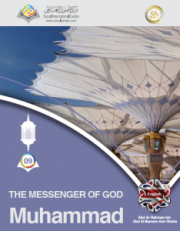
The messenger of God Muhammad
This book focuses on the biography of Prophet Muhammad, Peace Be upon Him, we will explore the vast expanse of the Prophethood to know the fine character of Prophet Muhammad, Peace Be upon Him, and His humble life. We will see how He strived to Allah with the striving due to Him. We will look through his benevolent attitude towards His enemies, His unprecedented nobility and unique method in calling people to Islam.
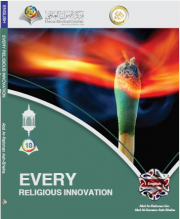
Every Religious Innovation
The book defines bid’ah (religious innovation) and numerates its kinds. It shows its negative effects on the lives of Muslims, and on how non-Muslims perceive Islam. The book clarifies the Islamic position with regard to bid’ah in religion; it shows the role of every Muslim in fighting bid’ah according to his capacity and resources.

Jesus in the Quran
The book then discusses the life story of Prophet Jesus, the Son of Mary, Peace be upon both of them. It starts with the time before he was born, when he was still a fetus in his mother’s womb. Then, it mentions his birth, his call to people to have faith, what he went through from his people, till He was ascended to Heaven by Almighty Allah. The writer includes how the Quran described this noble Prophet, a description that shows his high status for Almighty Allah.

The Beginning and The End
The book discusses the topic of the creation of the universe and how it started, because it is one of the topics that caught the attention and focus of many people over the course of times, the writer explains the aim of creating the worlds of humans and jinn, i.e. worshipping Allah alone, and that everything and everyone in this world is destined to die, then they will be resurrected and held accountable for what they did on the Day of Judgment.
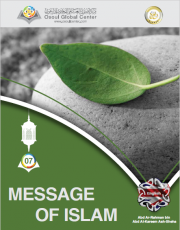
The Message of Islam
The writer started his book by stating a very important fact which is that Islam, its belief, acts of worship, transactions and teachings, ever since they were revealed to the Messenger, Peace Be upon Him, have not been changed even though some of Islam's followers have changed. Then, the book discusses the basic principals of Islam, shedding light on a number of rights guaranteed by Islam.
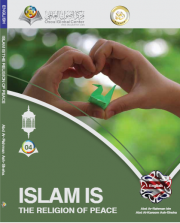
Islam is The religion of peace
The book makes clear that when the early Muslims overpowered major empires and took over vast areas, their motives were not to subjugate people or to enrich themselves. Indeed Islam stands firmly against injustice, tyranny and corruption and builds a state where all people, Muslims and non-Muslims can enjoy full justice and true compassion. Islam helps people to discard the worship of other beings so that they worship God alone. DOWNLOAD
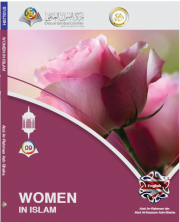
Women in Islam
Shedding light on the status of women prior to Islam, this book explains that women were ill-treated and humiliated in many cultures and how Islam put an end to all this injustice, gave women their proper status and established their rights. Islam considers that men and women have two different, but mutually complementary, roles in the family and in society and the relationship between them must be one of love and compassion. Both men and women are accountable to God for their deeds.

Ease and Tolerance in Islam
Ease and Tolerance: Two beautiful, intrinsic qualities of Islam.
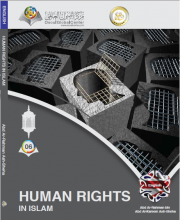
Human Rights in Islam
Human rights in Islam are outlined in the Qur'an and the teachings of Prophet Muhammad (peace be upon him) and aim at making man lead a life of compassion and dignity, so that he acquires all good qualities and deals with others in the best manner. The book clarifies the misconceptions that are often expressed regarding the different aspects of freedom and responds to criticism in a calm and objective way. DOWNLOAD
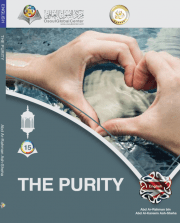
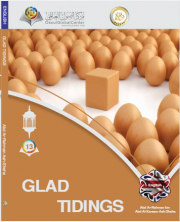
Glad Tidings
The author wanted to show the reality and essence of Islam to remove the mist from the eyes of those who believe that Islam is only the religion of Arabs, or those who link between Islam and backwardness and aggression, or those who depict the image of Islam from the practices of irresponsible Muslims. The book also sheds light on the characteristics of Islam and its merits, and gives good news to non-Muslims who want to embrace it that Allah will erase all their sins committed before, evidenced by the words of the Prophet Muhammad (peace be upon him): "Islamwipes out the sins committed before...". We will be glad to receive your comments and feedback after reading the book.
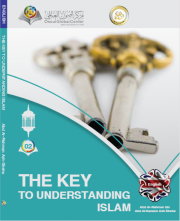
The Key to Understanding Islam
This book explains that Islam is a code of living that covers all aspects of life. It comprises a set of acts of worship: some verbal, some practical and others that are constituents of belief. All of them play important roles in placing morality on a solid foundation and in strengthening the good qualities in people so that they are keen to follow the right path, ensuring social unity and strengthening bonds within the community. The book cites many examples and speaks about the importance Islamattaches to knowledge. It mentions a number of recent scientific discoveries that the Qur’an referred to fourteen centuries ago.
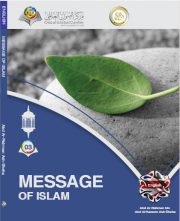
The Message of Islam
The Message of Islam begins by asserting the important fact that the faith of Islam, its worship, the rules governing people’s transactions and all its teachings have remained exactly the same as they were taught by Prophet Muhammad (peace be upon him) and no change or alteration was ever introduced into them.

Romance in Islam
In this book we will openly discuss issues that pertain to 'romance in Islam'. It is important for anyone seeking insight into the religion of Islam that they understand that Islam is not simply a 'religion', it is a way of life. The Prophet was very keen in instilling high moral character in his Companionsand he himself lived by a high moral standard. DOWNLOAD
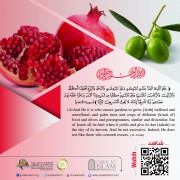
My first steps in Islam
In order to become a Muslim, there are no specific religious rituals or customs that you need to perform, neither in specific areas nor in front of people.
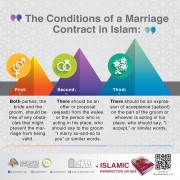
Islamic Perspective on Sex
This book discusses the Islamic approach to sex and how to satisfy sexual desires in the proper and beneficial way. When conducted in the lawful manner sex may be elevated to the rank of worship and a Muslim is rewarded for it.

Bilal the Abyssinian – One Light, Many Colors
This book, Bilal ibn Rabah: Islam's Attitude to Racial Discrimination, outlines the history of Bilal ibn Rabah, a former slave from Abyssinia who became a companion of the Prophet.

test from omm
Just just just just think about the world 1400 years ago and the level of knowledge that existed, or perhaps we should say the level ignorance that was prevalent, especially in regards to the natural world. Of course some thinkers and philosophers had made some amazing discoveries, even estimating the circumference of the earth, but they also got a lot of things very wrong. Legends and myths also abounded. Reading the Quran, you find a distinct lack of such legends and myths about the creation of the universe and the natural world. Yes, there are miracles and wonders worked by the Creator to increase the faith of the faithful and confound the obstinate, but otherwise descriptions of the world and universe seem remarkably modern. You would expect the Quran to reflect the myths and legends of the time. Even if Mohammed had managed to pick up the best ideas of the time and leave out these legends, it still does not account for the remarkable consistency of the Quran with modern science. Here are a couple of verses in the Quran dealing with the universe and its creation. “Do not the Unbelievers see that the heavens and the earth were joined together (as one unit of creation), before We clove them asunder, and We made from water every living thing. Will they not then believe?” [The Quran; Chapter 21 – The Prophets, verse 30} Ever heard of the Big Bang and how the universe started as a singularity, a super-condensed ball of matter and energy? We talked about that in the beginning, remember? It sure seems that the information in the Quran is correct about something that we discovered just about seventy years ago. Then how about this: “And it is We who have constructed the heaven with might, and verily, it is We who are steadily expanding it.” [The Quran; Chapter 51 – The Winds That Scatter, verse 47] When Einstein was conjuring up his theories, the consensus among scientists was that the universe was static and had been like that forever, but new observations made it clear that this was not the case and that in fact galaxies were moving away from each other at a constant rate. In other words, the universe is expanding. More than strange is how these things came to be found in a book 1400 years old. Science is a very fickle fellow. Things which scientists all agree upon at one time are turned on their heads and are shown to be contradicted by observations at another time, so perhaps it’s not the best thing to judge a book by. Still, there are some things that seem to have been observed so often and so much that it becomes some sort of ‘fact’. One of these things is the embryonic development of humans. The idea that we go through stages of foetal development is really quite new. Lots of theories abounded in antiquity and early modern times that today seem to sound a bit silly. For example, one of the dominant theories that was prevalent in the eighteenth century was the pre-formation theory. This was the idea that animals existed pre-formed in the sperm. There were even claims of observations of this through the primitive microscopes available at the time. So much for seeing is believing! Aristotle thought that menstrual blood congealed with the aid of semen to form a foetus. It was not until the late nineteenth century that what we know today began to be clearly articulated. Yet over 1400 years ago the Quran stated: “Man We did fashion from a quintessence of clay. Then We placed him as (a drop of) fluid in a place of rest firmly fixed. Then We fashioned the fluid into a leech-like thing that clings (the word “alaq” is sometimes incorrectly translated as a blood-clot). Then We fashioned that leech-like thing that clings into a chewed-like lump. Then We fashioned the chewed-like lump into bones and We clothed the bones with flesh. Then We developed out of it another creature. So hallowed be Allah, the Best of Artisans”; [The Quran; Chapter 96 – The Clot, verses 1-2]: “…who fashioned man from a leech-like thing that clings”; and [The Quran; Chapter 22 – The Pilgrimage, verse 5]: “We fashioned you out of dust, then out of a drop of fluid, then out of a leech-like thing that clings, then out of a morsel of flesh – partly formed and partly unformed…” Keith Moore, Professor and Chairman, Department of Anatomy, University of Toronto, Canada, and author of ‘The Developing Human’, and considered one of the world’s leading embryologists, said concerning these statements in the Qur’an and authenticated hadeeth: “Until the 19th Century, nothing was known about classifying the stages of human development. A system of staging human embryos was developed around the end of the 19th Century based on alphabetical symbols. During the 20th century, numerals were used to describe 23 stages of embryonic development. This system of numbering the stages is not easy to follow and a better system would be based on the morphological changes. In recent years, the study of the Qur’an has revealed another basis for the classification of the stages of the developing embryo which is based on easily understood actions and changes in shape. It utilizes terms which were sent from God to Muhammed the Prophet by the Angel Gabriel and recorded on the Qur’an … It is clear to me that these statements must have come to Muhammad from God because almost all of this knowledge was not discovered until many centuries later. This proves to me that Muhammed must have been a Messenger of God.” Marshall Jonson, Professor and Chairman, Department of Anatomy, Director of the Daniel Baugh Institute, Thomas Jefferson University, Philadelphia, U.S.A., said: “As a scientist I can only deal with things I can specifically see. I can understand embryology and developmental biology; I can understand the words that are translated to me from the Qur’an. If I were to transpose myself into that era, knowing what I do today and describing things, I could not describe the things that were described. I see no evidence to refute the concept that this individual Muhammed had to be developing this information from some place, so I see nothing in conflict with the concept that Divine Intervention was involved on what he was able to say.”

test from omm
Just just just just think about the world 1400 years ago and the level of knowledge that existed, or perhaps we should say the level ignorance that was prevalent, especially in regards to the natural world. Of course some thinkers and philosophers had made some amazing discoveries, even estimating the circumference of the earth, but they also got a lot of things very wrong. Legends and myths also abounded. Reading the Quran, you find a distinct lack of such legends and myths about the creation of the universe and the natural world. Yes, there are miracles and wonders worked by the Creator to increase the faith of the faithful and confound the obstinate, but otherwise descriptions of the world and universe seem remarkably modern. You would expect the Quran to reflect the myths and legends of the time. Even if Mohammed had managed to pick up the best ideas of the time and leave out these legends, it still does not account for the remarkable consistency of the Quran with modern science. Here are a couple of verses in the Quran dealing with the universe and its creation. “Do not the Unbelievers see that the heavens and the earth were joined together (as one unit of creation), before We clove them asunder, and We made from water every living thing. Will they not then believe?” [The Quran; Chapter 21 – The Prophets, verse 30} Ever heard of the Big Bang and how the universe started as a singularity, a super-condensed ball of matter and energy? We talked about that in the beginning, remember? It sure seems that the information in the Quran is correct about something that we discovered just about seventy years ago. Then how about this: “And it is We who have constructed the heaven with might, and verily, it is We who are steadily expanding it.” [The Quran; Chapter 51 – The Winds That Scatter, verse 47] When Einstein was conjuring up his theories, the consensus among scientists was that the universe was static and had been like that forever, but new observations made it clear that this was not the case and that in fact galaxies were moving away from each other at a constant rate. In other words, the universe is expanding. More than strange is how these things came to be found in a book 1400 years old. Science is a very fickle fellow. Things which scientists all agree upon at one time are turned on their heads and are shown to be contradicted by observations at another time, so perhaps it’s not the best thing to judge a book by. Still, there are some things that seem to have been observed so often and so much that it becomes some sort of ‘fact’. One of these things is the embryonic development of humans. The idea that we go through stages of foetal development is really quite new. Lots of theories abounded in antiquity and early modern times that today seem to sound a bit silly. For example, one of the dominant theories that was prevalent in the eighteenth century was the pre-formation theory. This was the idea that animals existed pre-formed in the sperm. There were even claims of observations of this through the primitive microscopes available at the time. So much for seeing is believing! Aristotle thought that menstrual blood congealed with the aid of semen to form a foetus. It was not until the late nineteenth century that what we know today began to be clearly articulated. Yet over 1400 years ago the Quran stated: “Man We did fashion from a quintessence of clay. Then We placed him as (a drop of) fluid in a place of rest firmly fixed. Then We fashioned the fluid into a leech-like thing that clings (the word “alaq” is sometimes incorrectly translated as a blood-clot). Then We fashioned that leech-like thing that clings into a chewed-like lump. Then We fashioned the chewed-like lump into bones and We clothed the bones with flesh. Then We developed out of it another creature. So hallowed be Allah, the Best of Artisans”; [The Quran; Chapter 96 – The Clot, verses 1-2]: “…who fashioned man from a leech-like thing that clings”; and [The Quran; Chapter 22 – The Pilgrimage, verse 5]: “We fashioned you out of dust, then out of a drop of fluid, then out of a leech-like thing that clings, then out of a morsel of flesh – partly formed and partly unformed…” Keith Moore, Professor and Chairman, Department of Anatomy, University of Toronto, Canada, and author of ‘The Developing Human’, and considered one of the world’s leading embryologists, said concerning these statements in the Qur’an and authenticated hadeeth: “Until the 19th Century, nothing was known about classifying the stages of human development. A system of staging human embryos was developed around the end of the 19th Century based on alphabetical symbols. During the 20th century, numerals were used to describe 23 stages of embryonic development. This system of numbering the stages is not easy to follow and a better system would be based on the morphological changes. In recent years, the study of the Qur’an has revealed another basis for the classification of the stages of the developing embryo which is based on easily understood actions and changes in shape. It utilizes terms which were sent from God to Muhammed the Prophet by the Angel Gabriel and recorded on the Qur’an … It is clear to me that these statements must have come to Muhammad from God because almost all of this knowledge was not discovered until many centuries later. This proves to me that Muhammed must have been a Messenger of God.” Marshall Jonson, Professor and Chairman, Department of Anatomy, Director of the Daniel Baugh Institute, Thomas Jefferson University, Philadelphia, U.S.A., said: “As a scientist I can only deal with things I can specifically see. I can understand embryology and developmental biology; I can understand the words that are translated to me from the Qur’an. If I were to transpose myself into that era, knowing what I do today and describing things, I could not describe the things that were described. I see no evidence to refute the concept that this individual Muhammed had to be developing this information from some place, so I see nothing in conflict with the concept that Divine Intervention was involved on what he was able to say.”

Reward of repentance
This is a very important topic on Repentance shows the Importance of making Tawbah, its conditio
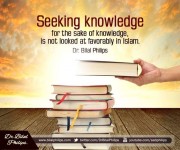
How to seek knowledge
The recording covers the virtue and significance of seeking knowledge including the individual duty and incentive to seek out knowledge, the correct Method for seeking religious knowledge, the Ethics of the seeker of it and what every Muslims should know about his or her Deen, Islam.

test from omm
Just just just just think about the world 1400 years ago and the level of knowledge that existed, or perhaps we should say the level ignorance that was prevalent, especially in regards to the natural world. Of course some thinkers and philosophers had made some amazing discoveries, even estimating the circumference of the earth, but they also got a lot of things very wrong. Legends and myths also abounded. Reading the Quran, you find a distinct lack of such legends and myths about the creation of the universe and the natural world. Yes, there are miracles and wonders worked by the Creator to increase the faith of the faithful and confound the obstinate, but otherwise descriptions of the world and universe seem remarkably modern. You would expect the Quran to reflect the myths and legends of the time. Even if Mohammed had managed to pick up the best ideas of the time and leave out these legends, it still does not account for the remarkable consistency of the Quran with modern science. Here are a couple of verses in the Quran dealing with the universe and its creation. “Do not the Unbelievers see that the heavens and the earth were joined together (as one unit of creation), before We clove them asunder, and We made from water every living thing. Will they not then believe?” [The Quran; Chapter 21 – The Prophets, verse 30} Ever heard of the Big Bang and how the universe started as a singularity, a super-condensed ball of matter and energy? We talked about that in the beginning, remember? It sure seems that the information in the Quran is correct about something that we discovered just about seventy years ago. Then how about this: “And it is We who have constructed the heaven with might, and verily, it is We who are steadily expanding it.” [The Quran; Chapter 51 – The Winds That Scatter, verse 47] When Einstein was conjuring up his theories, the consensus among scientists was that the universe was static and had been like that forever, but new observations made it clear that this was not the case and that in fact galaxies were moving away from each other at a constant rate. In other words, the universe is expanding. More than strange is how these things came to be found in a book 1400 years old. Science is a very fickle fellow. Things which scientists all agree upon at one time are turned on their heads and are shown to be contradicted by observations at another time, so perhaps it’s not the best thing to judge a book by. Still, there are some things that seem to have been observed so often and so much that it becomes some sort of ‘fact’. One of these things is the embryonic development of humans. The idea that we go through stages of foetal development is really quite new. Lots of theories abounded in antiquity and early modern times that today seem to sound a bit silly. For example, one of the dominant theories that was prevalent in the eighteenth century was the pre-formation theory. This was the idea that animals existed pre-formed in the sperm. There were even claims of observations of this through the primitive microscopes available at the time. So much for seeing is believing! Aristotle thought that menstrual blood congealed with the aid of semen to form a foetus. It was not until the late nineteenth century that what we know today began to be clearly articulated. Yet over 1400 years ago the Quran stated: “Man We did fashion from a quintessence of clay. Then We placed him as (a drop of) fluid in a place of rest firmly fixed. Then We fashioned the fluid into a leech-like thing that clings (the word “alaq” is sometimes incorrectly translated as a blood-clot). Then We fashioned that leech-like thing that clings into a chewed-like lump. Then We fashioned the chewed-like lump into bones and We clothed the bones with flesh. Then We developed out of it another creature. So hallowed be Allah, the Best of Artisans”; [The Quran; Chapter 96 – The Clot, verses 1-2]: “…who fashioned man from a leech-like thing that clings”; and [The Quran; Chapter 22 – The Pilgrimage, verse 5]: “We fashioned you out of dust, then out of a drop of fluid, then out of a leech-like thing that clings, then out of a morsel of flesh – partly formed and partly unformed…” Keith Moore, Professor and Chairman, Department of Anatomy, University of Toronto, Canada, and author of ‘The Developing Human’, and considered one of the world’s leading embryologists, said concerning these statements in the Qur’an and authenticated hadeeth: “Until the 19th Century, nothing was known about classifying the stages of human development. A system of staging human embryos was developed around the end of the 19th Century based on alphabetical symbols. During the 20th century, numerals were used to describe 23 stages of embryonic development. This system of numbering the stages is not easy to follow and a better system would be based on the morphological changes. In recent years, the study of the Qur’an has revealed another basis for the classification of the stages of the developing embryo which is based on easily understood actions and changes in shape. It utilizes terms which were sent from God to Muhammed the Prophet by the Angel Gabriel and recorded on the Qur’an … It is clear to me that these statements must have come to Muhammad from God because almost all of this knowledge was not discovered until many centuries later. This proves to me that Muhammed must have been a Messenger of God.” Marshall Jonson, Professor and Chairman, Department of Anatomy, Director of the Daniel Baugh Institute, Thomas Jefferson University, Philadelphia, U.S.A., said: “As a scientist I can only deal with things I can specifically see. I can understand embryology and developmental biology; I can understand the words that are translated to me from the Qur’an. If I were to transpose myself into that era, knowing what I do today and describing things, I could not describe the things that were described. I see no evidence to refute the concept that this individual Muhammed had to be developing this information from some place, so I see nothing in conflict with the concept that Divine Intervention was involved on what he was able to say.”

test from omm
Just just just just think about the world 1400 years ago and the level of knowledge that existed, or perhaps we should say the level ignorance that was prevalent, especially in regards to the natural world. Of course some thinkers and philosophers had made some amazing discoveries, even estimating the circumference of the earth, but they also got a lot of things very wrong. Legends and myths also abounded. Reading the Quran, you find a distinct lack of such legends and myths about the creation of the universe and the natural world. Yes, there are miracles and wonders worked by the Creator to increase the faith of the faithful and confound the obstinate, but otherwise descriptions of the world and universe seem remarkably modern. You would expect the Quran to reflect the myths and legends of the time. Even if Mohammed had managed to pick up the best ideas of the time and leave out these legends, it still does not account for the remarkable consistency of the Quran with modern science. Here are a couple of verses in the Quran dealing with the universe and its creation. “Do not the Unbelievers see that the heavens and the earth were joined together (as one unit of creation), before We clove them asunder, and We made from water every living thing. Will they not then believe?” [The Quran; Chapter 21 – The Prophets, verse 30} Ever heard of the Big Bang and how the universe started as a singularity, a super-condensed ball of matter and energy? We talked about that in the beginning, remember? It sure seems that the information in the Quran is correct about something that we discovered just about seventy years ago. Then how about this: “And it is We who have constructed the heaven with might, and verily, it is We who are steadily expanding it.” [The Quran; Chapter 51 – The Winds That Scatter, verse 47] When Einstein was conjuring up his theories, the consensus among scientists was that the universe was static and had been like that forever, but new observations made it clear that this was not the case and that in fact galaxies were moving away from each other at a constant rate. In other words, the universe is expanding. More than strange is how these things came to be found in a book 1400 years old. Science is a very fickle fellow. Things which scientists all agree upon at one time are turned on their heads and are shown to be contradicted by observations at another time, so perhaps it’s not the best thing to judge a book by. Still, there are some things that seem to have been observed so often and so much that it becomes some sort of ‘fact’. One of these things is the embryonic development of humans. The idea that we go through stages of foetal development is really quite new. Lots of theories abounded in antiquity and early modern times that today seem to sound a bit silly. For example, one of the dominant theories that was prevalent in the eighteenth century was the pre-formation theory. This was the idea that animals existed pre-formed in the sperm. There were even claims of observations of this through the primitive microscopes available at the time. So much for seeing is believing! Aristotle thought that menstrual blood congealed with the aid of semen to form a foetus. It was not until the late nineteenth century that what we know today began to be clearly articulated. Yet over 1400 years ago the Quran stated: “Man We did fashion from a quintessence of clay. Then We placed him as (a drop of) fluid in a place of rest firmly fixed. Then We fashioned the fluid into a leech-like thing that clings (the word “alaq” is sometimes incorrectly translated as a blood-clot). Then We fashioned that leech-like thing that clings into a chewed-like lump. Then We fashioned the chewed-like lump into bones and We clothed the bones with flesh. Then We developed out of it another creature. So hallowed be Allah, the Best of Artisans”; [The Quran; Chapter 96 – The Clot, verses 1-2]: “…who fashioned man from a leech-like thing that clings”; and [The Quran; Chapter 22 – The Pilgrimage, verse 5]: “We fashioned you out of dust, then out of a drop of fluid, then out of a leech-like thing that clings, then out of a morsel of flesh – partly formed and partly unformed…” Keith Moore, Professor and Chairman, Department of Anatomy, University of Toronto, Canada, and author of ‘The Developing Human’, and considered one of the world’s leading embryologists, said concerning these statements in the Qur’an and authenticated hadeeth: “Until the 19th Century, nothing was known about classifying the stages of human development. A system of staging human embryos was developed around the end of the 19th Century based on alphabetical symbols. During the 20th century, numerals were used to describe 23 stages of embryonic development. This system of numbering the stages is not easy to follow and a better system would be based on the morphological changes. In recent years, the study of the Qur’an has revealed another basis for the classification of the stages of the developing embryo which is based on easily understood actions and changes in shape. It utilizes terms which were sent from God to Muhammed the Prophet by the Angel Gabriel and recorded on the Qur’an … It is clear to me that these statements must have come to Muhammad from God because almost all of this knowledge was not discovered until many centuries later. This proves to me that Muhammed must have been a Messenger of God.” Marshall Jonson, Professor and Chairman, Department of Anatomy, Director of the Daniel Baugh Institute, Thomas Jefferson University, Philadelphia, U.S.A., said: “As a scientist I can only deal with things I can specifically see. I can understand embryology and developmental biology; I can understand the words that are translated to me from the Qur’an. If I were to transpose myself into that era, knowing what I do today and describing things, I could not describe the things that were described. I see no evidence to refute the concept that this individual Muhammed had to be developing this information from some place, so I see nothing in conflict with the concept that Divine Intervention was involved on what he was able to say.”
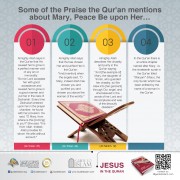
Jesus in the Quran IV
Some of the praise the Quran mentions about Mary, peace be upon Her. ..

